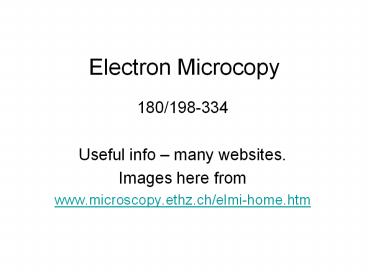Electron Microcopy - PowerPoint PPT Presentation
Title:
Electron Microcopy
Description:
These signals are mainly exploited in TEM and electron diffraction. ... EDXS) Electron Energy ... planes Examples of low index planes Important ... – PowerPoint PPT presentation
Number of Views:216
Avg rating:3.0/5.0
Title: Electron Microcopy
1
Electron Microcopy
- 180/198-334
- Useful info many websites.
- Images here from
- www.microscopy.ethz.ch/elmi-home.htm
2
De Brogle wavelength of electrons
100 KeV electron has 3.7 pm wavelength!
3
Electron-matter interactions
4
Electron-matter interactions
EDXS spectrum
5
Elastic interactions
- No energy is transferred from
- the electron to the sample.
- The electron either passes without
- any interaction (direct beam) or
- is scattered by the positive
- potential inside the electron
- cloud.
- These signals are mainly
- exploited in TEM and electron
- diffraction.
6
Inelastic Interactions
Energy is transferred from the incident electrons
to the sample secondary electrons, phonons, UV
quanta or cathodoluminescence are
produced shooting out inner shell
electrons leads to the emission of X-rays or
Auger electrons. These signals are used in
analytical electron microscopy.
Excellent manuscript www.microscopy.ethz.ch/downl
oads/Interactions.pdf
7
Interaction volumes
8
Energy dependence
9
Energy dependence II
10
Some SEM images
11
Backscattered electrons
Material contrast
12
Basic TEM and SEM
13
Which EM to use?
- The method that is needed is determined by the
question to be solved - Structure (High-Resolution) Transmission
Electron Microscopy - Scanning Transmission Electron Microscopy
(STEM) - Electron diffraction (ED)
- Composition Energy-dispersive X-ray
spectroscopy (EDXS) - Electron Energy Loss Spectroscopy (EELS)
- Morphology Scanning Electron Microscopy (SEM)
- Elemental mapping
- Electron Spectroscopic Imaging (ESI)
- STEM X-ray spectroscopy / EELS
- SEM X-ray spectroscopy
14
De Brogle wavelength of electrons
100 KeV electron has 3.7 pm wavelength! Is this
the limit?
15
Scattering and diffraction
- Experiment
- Basic structures and how to label them
- X-ray diffraction
16
Experiment
17
Braggs Law
constructive interference destructive
interference of waves
18
Crystal symmetries finite number!
- 7 crystal systems The crystal systems are a
grouping of crystal structures according to the
axial system used to describe their lattice. Each - crystal system consists of a set of three
axes in a particular geometrical arrangement. - Cubic, hexagonal, tetragonal, rhombohedral (also
known as trigonal) - orthorhombic, monoclinic and triclinic.
- 14 Bravais lattices When the crystal systems are
combined with the various possible lattice
centerings, we arrive at the Bravais lattices.
They describe the geometric arrangement of the
lattice points, and thereby the translational
symmetry of the crystal.
19
Unit cells of a cubic crystal 3 different
Bravais lattices
20
Directions in a cubic crystal
21
Miller indices of crystal planes
22
Examples of low index planes
23
Important results for cubic systems
24
Important results for cubic systems































